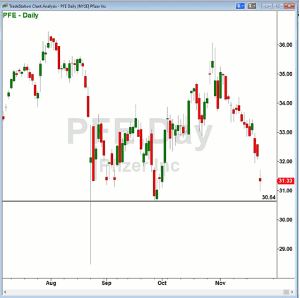As a follow-up to last week's article, options instructor Russ Allen, of Online Trading Academy, goes into further detail—citing the same stock example for support—regarding two different kinds of option plays, buying call options versus selling puts short instead.
Last week I discussed the idea that when trading options, some option trades are designed to profit when a stock does move, while others make money when the stock does not move. As promised, this is the second installment of that discussion.
As an example, I described a bullish opportunity in the stock of Pfizer (PFE). It looked as though it had a good chance of moving up. Here is the chart as it appeared then:
We looked at two different kinds of option plays.
The first and most straightforward was to buy call options on PFE. Our example used the 30-strike calls expiring in February, which we could buy for $2.10 per share. If the stock went up far enough, the calls could make a large amount of money. If the stock went down, this trade would naturally lose. In fact, if the stock remained flat, or even if it went up but by only a small amount, the calls would lose value as a function of the passage of time. In a month, without movement by the stock, the calls would lose about $.30 per share of their $2.10 value. The stock had to go up enough to more than offset this for that trade to show a profit. The worst case would be if PFE dropped to a very low price, far below $30. In that case, the entire $2.10 cost of the call could be lost.
Secondly, as an alternative to buying calls, we looked at selling puts short instead. We selected the December 30-strike puts which could be sold for $.32 per share. The goal of this trade would be to collect that $.32 per share now and keep it as clear profit when the puts expired in December.
In contrast to the long call trade, this one did not require that the stock move up at all. If PFE remained stationary, or even went down from the current price of $31.33 by a limited amount (to any price that was still above $30), the $.32 maximum profit would still be made. For this short put trade to show an actual loss PFE would have to drop to a price lower than $29.68 and remain there until the December expiration. This price represents the put strike of $30, reduced by the premium received of $.32. The chance of PFE remaining above $29.68 for a month was statistically very high, showing about an 82% probability. We believed the chances were even better than that because of a good demand zone at around $30.64-$31.00.
NEXT PAGE: How to Protect Either Plan
|pagebreak|So, both the long call trade and the short put trade would be profitable if PFE went up. The short put trade showed a much smaller maximum profit ($.32) than the long call trade (unlimited), but had a much higher probability of making that profit. In other words, it was a choice between a small chance of making a lot of money on the calls versus a large chance of making a small amount of money on the puts.
Whether we decided on the long calls or the short puts, we would plan to protect either trade with a stop-loss order to take us out of it if PFE fell below a stop-loss price around $30.50. Like any stop-loss order, these would be fully effective in protecting us only if the price of PFE traded smoothly down through that price enabling us to exit immediately with the stock price very near it. In that event, neither trade would suffer much of a loss, with the long call trade being hurt more than the short put trade. We would also have to take into account the small, but non-zero possibility that PFE could move overnight to a much lower price with no trades near the stop-loss price, opening one morning far below it. In that event the short puts could show a much larger loss (unlimited) than the long calls ($2.10 per share maximum loss).
Finally, we should consider the degree to which the options were overinflated or underinflated. When people expect a stock to move very fast (either up or down) they will pay inflated prices for its options. If they expect it to slow down—on the other hand—they will pay less for the options, possibly much less than they should. When trading options we will do better if we lean toward buying options when they are underinflated, while preferring instead to sell them short when they are overinflated. We can benefit if they then return to a more normal level of inflation, which is likely.
This level of inflation is called implied volatility. When people pay high prices for options, they imply by doing so that they expect an increased level of volatility of the stock price.
In this particular case, the implied volatility of PFE was just in the normal range, neither abnormally low nor high. That would not be the deciding factor in this trade. In many cases it will be just that.
Assessing a stock’s implied volatility is a key part of trading options profitably.
Until next time, trade safe, and know your options.
By Russ Allen, Instructor, Online Trading Academy






















